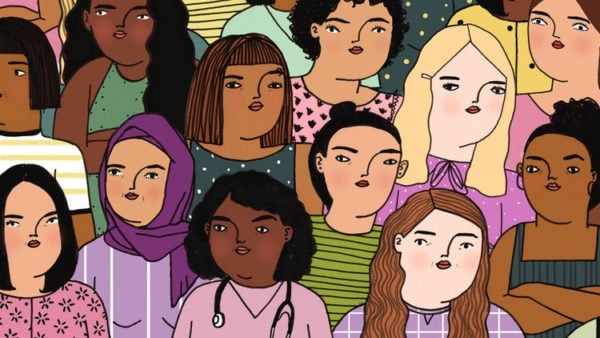This is one article in a series of Sundance coverage. Follow The Daily’s reviews of select Sundance films every day last week, extending through this week.
Sundance is known for its narrative fiction films, but the festival showcases a surprisingly large variety of films, including documentaries and unique types of films and media. I have reviewed three pieces — two films, one TV series — that I saw at Sundance and found worth noting.
“Narcissister Organ Player”
A half-documentary, half-performance piece from performance artist Narcissister, the also half-eponymous “Narcissister Organ Player” provides a careful look at the dancer and now-filmmaker. Narcissister chooses to always keep half of her face hidden by some sort of mask, choosing to cover childhood photos of herself that appear in the film. She prefers to remain a private person, partially to protect her privacy but also to remain in this explicit character.
The organs that “Narcissister Organ Player” so chooses to discuss are in fact not instruments but rather bodily organs. The film is a compilation of performance excerpts from her piece, Organ Player, in which she crawls in and out of various oversized models of female genitalia, incorporating messy physical art and complex costume changes that illustrate birth to death, love and transformation. While I had seen many Sundance pieces that address heavy themes, “Organ Player” was by far the one with the most explicit sexual content. Nevertheless, Narcissister’s art appears to essentially desexualize even the most sexual of themes and visuals, normalizing the female form. I could feel the tenseness in the audience when she first began to remove clothing, then a loosening as the film went on with more and more emotionally dense portions, and viewers began to relax and embrace it.
“Organ Player” also incorporates small pieces of the artist’s life. As a woman of color, Narcissister’s name comes from the idea of being a narcissist and a sister together — a certain kind of personal narcissism in hiding her face and protecting her own privacy but also being a sister in solidarity. Film clips that were originally filmed by Narcissister’s brother, especially ones of her mother, provided a look at Narcissister’s background and her upbringing and how they influence her work today. The coupling of very personal material from an artist who feels so separate from her identity as the Narcissister character was a fascinating juxtaposition alongside the extremely visceral art that Narcissister, as the artist, creates.
During Narcissister’s talkback after the film, she talked about distancing herself from the Narcissister character and the desire to keep these separate. She wore her signature mask during the discussion, but her soft-spoken, polite nature punctuated my thoughts. Narcissister’s performance art is heavily theatrical, and she is able to deliver a political and social message in it — maybe because she can keep her art and her identity separate.
“Lenny”
“Lenny” is a new HBO documentary series by Lena Dunham — judging by the content, I can only describe “Lenny” as the most Lena Dunham-esque docuseries I have ever seen. The bright animations and colorful music mirrored what I thought Dunham’s optimistic, outward-looking approach to being media-friendly was. I’ll admit that I haven’t watched the entirety of “Girls,” but everything I associate with Dunham, from press to the limited parts of the series that I have indeed watched, felt like it influenced “Lenny.”
Through the five short pieces that were screened, I was definitely engaged with all of them — but such brief pieces only provided a small, superficial glimpse into each subject. An “orgasmic meditation” seminar, an all-girls improv class, a Muslim women-only hairdresser — these were all unique settings for documentary pieces, but each piece felt almost like there was an ulterior motive at play. The fact is that these environments and communities were being utilized as somewhat of an exotic signposting of Dunham’s attempt at intersectional feminism. Even though I enjoyed and felt like I respected each of the films individually, such a short look at each seemed like cheating — a tiny glimpse of each small, nuanced world wasn’t enough.
The audience size at the “Lenny” screening wasn’t particularly large, but I wasn’t sure whether it was because of the timing or because of the press surrounding Dunham. I’m intrigued to see where this HBO series goes — maybe it’ll attract good press because of the unique format and content — or even Dunham’s name.
“Matangi/Maya/M.I.A.”
Every time it’s Super Bowl season, I’m often reminded of the 2012 M.I.A. Super Bowl controversy when the rapper flipped off the audience on live television, ended up being fined and eventually settled. This documentary film, which won the World Cinema Documentary Special Jury Award, addresses this elephant in the room and then tears it down, showcasing her as a multifaceted artist and human.
The film’s name comes from all of the names of British rapper M.I.A., born Mathangi Arulpragasam and called Maya during her formative years. The documentary provides an introspective look at M.I.A.’s life, her family, her artistic and creative journey, her path to hip-hop stardom and transformation into a controversial figure. M.I.A., a South Asian rapper of Sri Lankan Tamil background, rose quick as an incredibly unique voice in the hip-hop community.
As an art student and beyond, M.I.A. recorded a large series of videos of her everyday life, which were very informatively incorporated into the film, providing an intimate look at M.I.A. as a person — as Maya, rather than M.I.A. the rapper. Many of her albums are tributes to her parents and background, both titles, songs, lyrics, art and influence — and audiences fell in love with her bold, colorful vibe. Nevertheless, the film shows a tender side of M.I.A. — traveling back to Sri Lanka to spend time with her family and find herself in her music, wanting to be a documentary filmmaker when she was in college. If you’re looking for a documentary film that presents an engaging narrative of a public figure, watch “Matangi/Maya/M.I.A.,” and it might make you think twice about the infamous rapper.
Contact Olivia Popp at oliviapopp ‘at’ stanford.edu.



